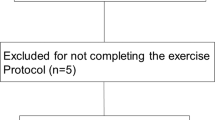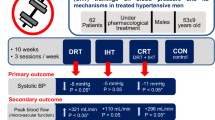Abstract
In groups of hypertensives blood-pressure (BP) reductions after relaxation training (RT) are generally moderate. One possibility to explain this relative weakness of RT follows from the observation of large interindividual differences in BP response after RT. In a first study we observed this same variability of BP response after RT in normotensives. Subsequently a method was developed to predict individual BP response after RT. The validity of this method was then established in three samples of normotensives: both systolic and diastolic BP changes appear to be predictable after progressive relaxation as well as after autogenic training.
Similar content being viewed by others
References
Agras, W. S. (1982). Weight reduction and blood pressure management: The generalized and enduring effects of two behavior-change procedures. In Stuart, R. B. (ed.),Adherence, Compliance, and Generalization in Behavioral Medicine, Brunner-Mazel, New York.
Agras, W. S., Taylor, C. B., Kraemer, H. C., Allen, R. A., and Schneider, J. A. (1980). Relaxation training. Twenty-four-hour blood pressure reductions.Arch. Gen. Psychiat. 37: 859–863.
Growther, J. H. (1983). Stress management training and relaxation imagery in the treatment of essential hypertension.J. Behav. Med. 6: 169–187.
English, E. H., and Baker, T. B. (1983). Relaxation training and cardiovascular response to experimental stressors.Health Psychol. 2: 239–259.
Eysenck, H. J., and Eysenck, S. B. G. (1964).Manual of the Eysenck Personality Inventory, University of London Press, London.
Frumkin, K., Nathan, R. J., Prout, M. F., and Cohen, M. C. (1978). Nonpharmacological control of essential hypertension in man: A critical review of the experimental literature.Psychosom. Med. 40: 294–320.
Godaert, G., and Schreurs, P. (1978). Relaxation training with essential hypertension. Presented at the 12th European Conference on Psychosomatic Research, Bodø, Norway.
Goldstein, I. B. (1982). Biofeedback in the treatment of hypertension. In White, L., Tursky, B. (eds.),Clinical Biofeedback. Efficacy and Mechanisms, Guilford, New York.
Herd, A. (1984). Cardiovascular disease and hypertension. In Gentry, W. D. (ed.),Handbook of Behavioral Medicine, Guilford, New York.
Jacob, R. G., Kraemer, H. C., and Agras, W. S. (1977). Relaxation therapy in the treatment of hypertension: A review.Arch. Gen. Psychiat. 34: 1417–1427.
Johnston, D. W. (1986). How does relaxation training reduce blood pressure in primary hypertension? In Schmidt, T., Dembroski, T., and Blümchen, G. (eds.),Biological and Psychological Factors in Cardiovascular Disease. Springer, Berlin-Heidelberg-New York.
Kuller, L. M., Crook, M., Almes, M. J., Detre, K., Reese, G., and Rutan, R. (1980). Dortmond High School (Pittsburg, Pa.) Blood Pressure Study.Hypertension 2: 109–116.
Lacey, J. I. (1956). The evaluation of autonomic responses: Toward a general solution.Ann. N. Y. Acad. Sci. 67: 123–164.
Luborsky, L., Crits-Christoph, P., Brady, J. P., Kron, R. E., Weiss, Th., Cohen, M., and Levy, L. (1982). Behavioral versus pharmacological treatments for essential hypertension — a needed comparison.Psychosom. Med. 44: 203–213.
Peters, R. K., Benson, H., and Peters, J. M. (1977). Daily relaxation response breaks in a working population. II. Effects on blood pressure.Am. J. Publ. Health 67: 954–959.
Rosenbaum, M. (1980). A schedule for assessing self control behaviors.Behav. Ther. 11: 74–86.
Wadden, T. A. (1983). Predicting treatment response to relaxation training for essential hypertension.J. Nerv. Ment. Dis. 171: 683–689.
Wilde, G. J. S. (1970).Neurotische Labiliteit Gemeten Volgens de Vragenlijst Methode, Van Rossen, Amsterdam.
Wilder, J. (1967).Stimulus and Response. The Law of Initial Value, J. Wright & Sons, Bristol.
Author information
Authors and Affiliations
Rights and permissions
About this article
Cite this article
Vinck, J., Arickx, M. & Hongenaert, M. Predicting interindividual differences in blood-pressure response to relaxation training in normotensives. J Behav Med 10, 395–410 (1987). https://doi.org/10.1007/BF00846478
Accepted:
Issue Date:
DOI: https://doi.org/10.1007/BF00846478




